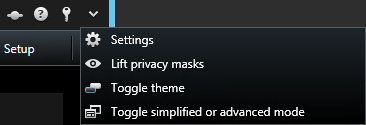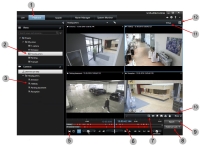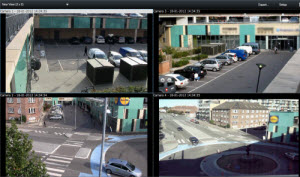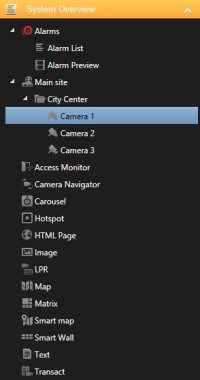Getting to know your XProtect Smart Client
The topics in this section can help you become familiar with the different areas your XProtect surveillance system.
View version and plug-in information
Knowing the exact version of your XProtect Smart Client can be important if you require support or want to upgrade. In such cases, you also need to know which plug-ins your XProtect Smart Client is using.
- To view this information, on the XProtect Smart Client toolbar, click Help > About

The version of your XProtect Smart Client affects which XProtect server version it is compatible with. The latest XProtect Smart Client is compatible with the latest server version and the previous server version.
User rights (explained)
Your user rights are specified centrally by your system administrator and these determine your ability to use particular XProtect Smart Client features.
Basically, your system administrator can restrict your rights to:
- Access the XProtect Smart Client
- Access each of the tabs: Live, Playback, Alarm Manager, and Search
- Setup mode
- Use specific features
- Create views that typically contain video from one or more cameras
- View video from specific cameras
The ability to use features of the XProtect Smart Client can vary considerably from user to user. When connected to certain VMSShort for "Video Management Software". systems, user rights may even vary depending on time of day, day of week, and so on. For example, you may only be able to view video from a particular camera during certain hours Monday-Friday, but not outside these hours.
Modes in XProtect Smart Client (explained)
XProtect Smart Client has two modes:
- Simplified mode - only the Live and Playback tabs are available, and you can perform a limited set of tasks. For more information, see Simplified mode overview
- Advanced mode - all features and tabs are available, and you can access the setup mode. For more information, see Advanced mode overview (Playback tab)
Depending on your product, XProtect Smart Client opens in simplified or advanced mode. If you change the default mode through the Toggle simplified or advanced mode button, XProtect Smart Client opens in the changed mode the next time you open the program.
The table gives you an overview of the XProtect Smart Client default mode according to the product.
|
Product |
Mode |
|---|---|
|
XProtect Corporate |
Advanced |
|
XProtect Expert |
Advanced |
|
XProtect Professional+ |
Advanced |
|
XProtect Express+ |
Advanced |
|
XProtect Essential+ |
Advanced |
|
XProtect Professional |
Simplified |
|
XProtect Express |
Simplified |
Simplified mode overview
The simplified mode provides only the most basic features. You can toggle between simplified and advanced mode by clicking  Toggle simplified or advanced mode.
Toggle simplified or advanced mode.
 View video - view live video, or play back recorded video to investigate an incident. Select a different view to view video from other cameras or other types of content.For more information, see:
View video - view live video, or play back recorded video to investigate an incident. Select a different view to view video from other cameras or other types of content.For more information, see:
 Get a closer look - tap or double-click a video to view it in full-screen mode. Tap or double-click again to exit the full-screen mode. Scroll to zoom in and out.
Get a closer look - tap or double-click a video to view it in full-screen mode. Tap or double-click again to exit the full-screen mode. Scroll to zoom in and out.
 Investigate recordings - Play back video forward or backward in time, adjust the time span, or scroll to quickly browse the recordings. You do this on the Playback tab.For more information, see:
Investigate recordings - Play back video forward or backward in time, adjust the time span, or scroll to quickly browse the recordings. You do this on the Playback tab.For more information, see:
 Create documentation - export a video clip or still imageA single static image. that shows what happened. You do this on the Playback tab.For more information, see:
Create documentation - export a video clip or still imageA single static image. that shows what happened. You do this on the Playback tab.For more information, see:
Advanced mode overview (Playback tab)
The picture shows what the Playback tab looks like in advanced mode. To switch to simplified mode, click  Toggle simplified or advanced mode.
Toggle simplified or advanced mode.
 View recorded video on the Playback tab. See Viewing recorded video (explained).
View recorded video on the Playback tab. See Viewing recorded video (explained).
 Select a view.
Select a view.
 Select a time span for exporting video. See Time navigation controls (explained).
Select a time span for exporting video. See Time navigation controls (explained).
 Browse using the timeline. See Timeline (explained).
Browse using the timeline. See Timeline (explained).
 Open a new search window with the camera preselected. See Search for video
Open a new search window with the camera preselected. See Search for video
 Create an evidence lock. See Evidence locks (explained).
Create an evidence lock. See Evidence locks (explained).
 Perform various actions on the camera toolbar. See Camera toolbar overview.
Perform various actions on the camera toolbar. See Camera toolbar overview.
 Enter setup mode. See Setup mode overview.
Enter setup mode. See Setup mode overview.
 View in full screen.
View in full screen.
Advanced mode overview (Live tab)
The picture shows what the Live tab looks like in advanced mode. To switch to simplified mode, click  Toggle simplified or advanced mode.
Toggle simplified or advanced mode.

| Button | Function | More information |
|---|---|---|
|
1 |
The different work areas. |
For more information, see Tabs in XProtect Smart Client. |
|
2 |
Select a view. |
For more information, see Views and shortcuts (explained) |
|
3 |
Change cameras in views. |
For more information, see Change cameras in views |
|
4 |
View recorded video using independent playback. |
For more information, see View recorded video independently of timeline |
|
5 |
The camera toolbar. |
For more information, see Camera toolbar overview |
|
6 |
Enter or exit setup mode to add cameras and other types of content to your views. |
For more information, see Setup mode overview |
|
7 |
Application buttons. |
For more information, see Application buttons (explained) |
Views (explained)
The way video is displayed in XProtect Smart Client is called a view. A view can contain video from up to 100 cameras, depending on your surveillance system. XProtect Smart Client can handle an unrestricted number of views, allowing you to switch between video from various groups of cameras. The layout of each view can be customized to fit its content. To help you maintain an overview, all views are placed in folders called groups. A group can contain any number of views and, if required, subgroups.
Views can be private or shared with other users.
In addition to video, views can display web pages and still images (for example, mugshots). For some surveillance systems, views can even display data from other applications (such as receipts from a cash register) alongside video. See Content in views (explained).
Your user settings, including information about your views, are stored centrally on the surveillance system server, so you can use your views on any computer that has a XProtect Smart Client installed.
Views and shortcuts (explained)
You can select a view from the Views pane on the Live and Playback tab. If neither the pane nor the shortcut is available, check the pane's availability in the Settings window under Panes.
If views have been assigned shortcut numbers , you will also be able to select a view by using keyboard shortcuts.
Content in views (explained)
Once you have defined a layout for your view, you can add different types of content to your view items. In setup mode, you can drag and drop these items from the System Overview pane into the view item.
- Alarms - the alarm list and alarm preview you can also find on the Alarm Manager tab
- Cameras - video feed from a live camera or video played back. The cameras appear under the site name, which is defined by your system administrator.
- Access Monitor - with XProtect® Access installed, you can set up access monitors, for example for a specific door
- Camera Navigator - allows you to navigate cameras on a map
- Carousel - shifts between cameras and at a pace that you define
- Hotspot - a hotspot window shows whatever camera is in focus in a high resolution or frame rate
- HTML page - import a webpage into the view, for example the web address of an online news channel
- Image - add images to views, for example to distribute a picture of a suspect.
- LPR - with XProtect® LPR installed, you can add LPR cameras to views
- Image - allows you to share images, for example of suspects
- Map - a floor plan or a geographical area
- Matrix - add a Matrix position to a view. See Matrix (explained)
- Smart Map - a geographical world map based on existing online map services, for example Google Maps and OpenStreetMap.
- Smart Wall - if XProtect Smart Wall has been configured by your system administrator, you can add video walls to your views. See XProtect Smart Wall (explained)
- Text - add text to you views
- Transact - if XProtect Transact has been installed in your system, you can add point-of-sales systems together with cameras.
Camera toolbar overview
 View recorded video independently of timeline
View recorded video independently of timeline
 Add a bookmark. See Bookmarks (explained)
Add a bookmark. See Bookmarks (explained)
Task buttons (explained)
The task buttons are on the XProtect Smart Client toolbar and to the right of the timeline. The task buttons available vary depending on the tab you are on. For example, Setup is not available on all tabs. These are the task buttons:
- Setup: click to enter setup mode (see Setup mode overview)
- Export: click to export video (see Export video in advanced mode)
- Evidence Lock: click to create an evidence lock (see Create evidence locks)
- Retrieve: Click to retrieve recordings from interconnected hardware devices or cameras that support edge storage
- Toggle full screen mode
 : click to toggle between full screen and a smaller window that you can adjust to the size you want
: click to toggle between full screen and a smaller window that you can adjust to the size you want
Application buttons (explained)

With the application buttons in the toolbar, you can select basic XProtect Smart Client actions:
- Status: Access the Status window. See Status window (explained)
- Help: Access the help system, play online video tutorials or view version number and plug-in information. See View version and plug-in information
- Log out: Log out XProtect Smart Client. See Log in and out
- Settings: Configure XProtect Smart Client settings and behavior, joysticks, keyboard shortcuts, and language. See Settings window (explained))
- Lift privacy masks: Users with sufficient rights can temporary lift privacy masksA blurred or solid color that covers an area of the video in the camera view. The defined areas are blurred or covered in live, playback, hotspot, carousel, smart map, smart search, and export modes in the clients.. See Privacy masking (explained)
- Toggle theme: Switch the XProtect Smart Client theme to dark or light
- Toggle simplified or advanced mode: Switch between simplified mode and advanced mode. See Modes in XProtect Smart Client (explained)
Status window (explained)
In the Status window, you can find information about:
- The status of the surveillance servers that your XProtect Smart Client is connected to through Milestone Federated Architecture. For more information, see Login information below.
- The jobs created for retrieving data from interconnected hardware devices or cameras that support edge storage. For more information, see Jobs below.
- The existing evidence locks that you have user rights to. For more information, see Evidence Lock List below.
To open the Status window, click the Status button in the application toolbar:
If the button appears with a red circle ![]() , one of more servers are unavailable. When you have viewed the status, the button will stop flashing red even if the server(s) are still unavailable.
, one of more servers are unavailable. When you have viewed the status, the button will stop flashing red even if the server(s) are still unavailable.
Here you can view the status of the surveillance servers your XProtect Smart Client is connected to. The dialog box is useful if you are connected to a surveillance system that supports Milestone Federated Architecture. Milestone Federated Architecture is a parent/child setup of related but physically separate surveillance systems. Such a setup can be relevant for, for example, chains of shops with many separate but related surveillance systems.
If servers are available, they will be displayed in gray:
![]()
If servers are not available at the time you log in, you cannot use cameras or features belonging to those servers. Unavailable servers are displayed in red:

The number of servers you see reflects the number of servers retrievable from the surveillance system at the time you logged in. Particularly if you connect to large hierarchies of servers, more servers may occasionally become available after you log in. The server list is a static representation of server status. If a server is unavailable, it will display a reason in the Status field when you click it. To attempt to connect to the server, click the Load Server button. The server status for that server will then be updated. If a server continues to be unavailable for longer periods of time, contact your surveillance system administrator for advice.
If your XProtect Smart Client is part of a Milestone Interconnect™ system and you have sufficient rights to retrieve data from interconnected hardware devices or cameras that support edge storage, you can view the jobs created for each data retrieval request for these devices.
Each camera where retrieval has been requested is displayed as a separate job. You can view the progress of the running jobs and you can stop the jobs from here. Related audio will automatically be retrieved, but these jobs will not show up anywhere. Once a job has completed, the timeline (see Timeline (explained)) for the device is automatically updated.
If you would like to only see the jobs you have requested, click the Only show my jobs filter.
You can sort, filter and search the evidence locks list and see additional information about them. You can only see evidence locks with devices that you have user rights to. For more information see View evidence locks.
Keyboard shortcuts (explained)
When you work on the Live and Playback tabs, a number of simple keyboard shortcuts are available.
The PLUS SIGN in the following shortcuts does not indicate the key but the combination of pressing two or more keys. For example, the keyboard shortcut /+ENTER indicates that you press the slash (/) key and then the ENTER key.
These shortcuts cannot be used for positions in views containing Matrix content or static images.
|
Press these keys |
To do this |
|
|---|---|---|
| ENTER |
Toggle maximized/regular display of the selected position in the view. |
|
| ALT |
Select a specific view item. When using ALT, you can navigate to a view item by entering the numbers displayed on the screen. When a view item is in focus, it is marked with a blue frame. If you are using a PTZ camera or a hotspot (see Hotspots (explained)), this allows you to control cameras with a joystick or to send the view item directly to the hotspot without using the mouse. |
|
| /+<camera shortcut number>+ENTER |
Change the camera in the selected view item to the camera with the matching shortcut number. Example: if the required camera has the shortcut number 6, press /+ 6+ENTER. Camera shortcut numbers may not necessarily be in use on your surveillance system. Camera shortcut numbers are defined on the server. |
|
| /+ENTER |
Change the camera in the selected view item to the default camera. |
|
| /+/+ENTER |
Change the cameras in all view items to the default cameras. |
|
| *+<view shortcut number>+ENTER |
Change the selected view to the view with the matching shortcut number. Example: if the required view has the shortcut number 8, press *+ 8+ENTER. View shortcut numbers may not necessarily be used. If view shortcut numbers are used, you can see them on the Live tab in the Views pane, where they appear in parentheses before the views' names. View shortcut numbers are defined on the Live tab in setup mode. |
|
| 6 (numeric keypad only) |
Move the view position selection one step to the right. |
|
| 4 (numeric keypad only) |
Move the view position selection one step to the left. |
|
| 8 (numeric keypad only) |
Move the view position selection one step up. |
|
| 2 (numeric keypad only) |
Move the view position selection one step down. |
|
You can also assign your own custom shortcut key combinations (see Keyboard settings) for particular actions in XProtect Smart Client.
Was this article helpful?
Thanks for your feedback!







